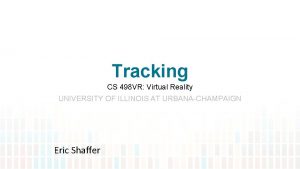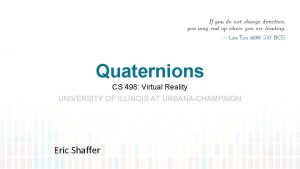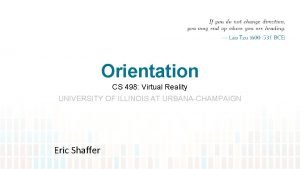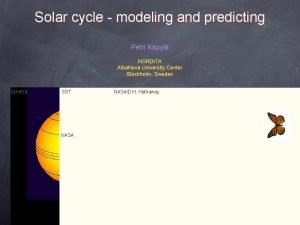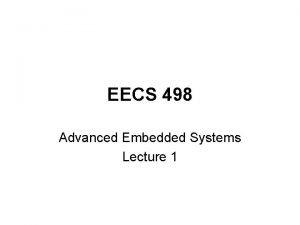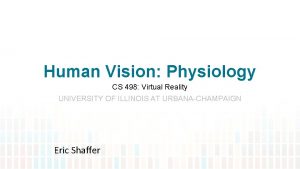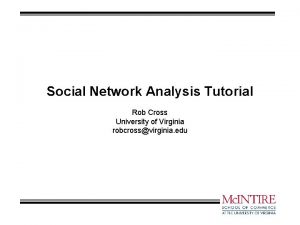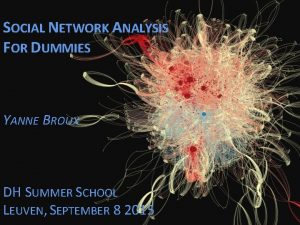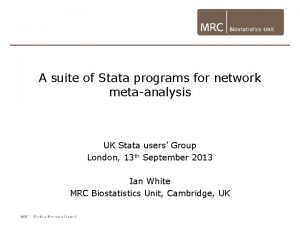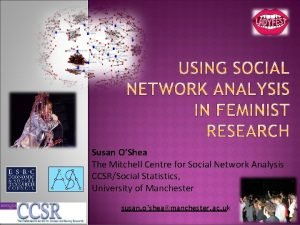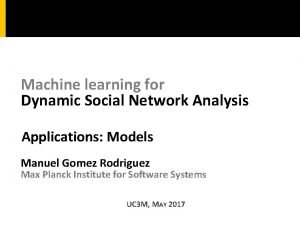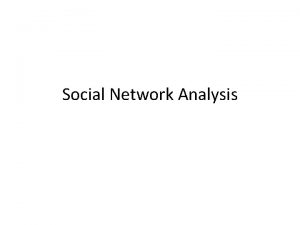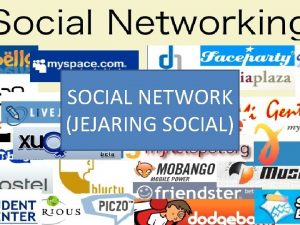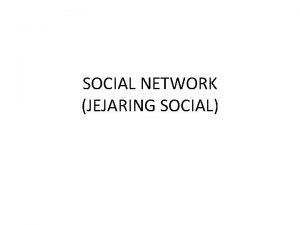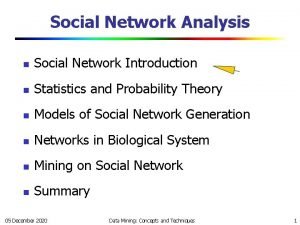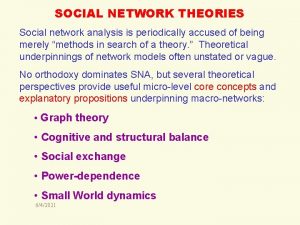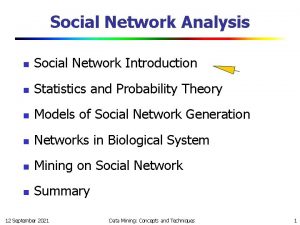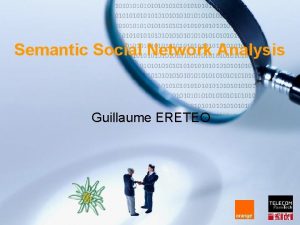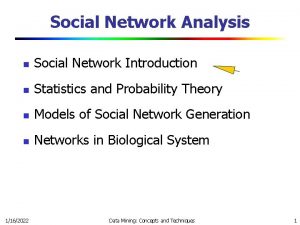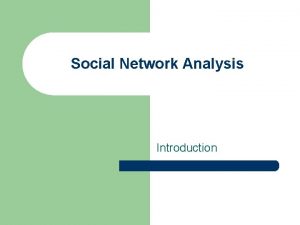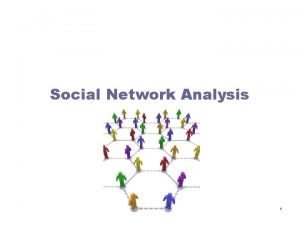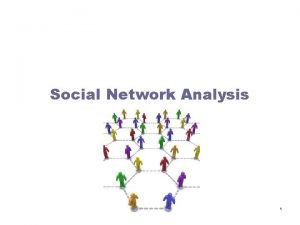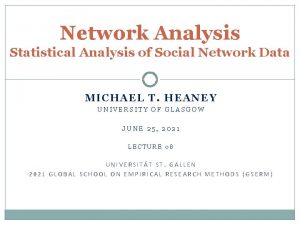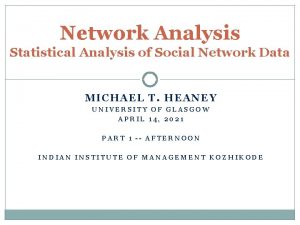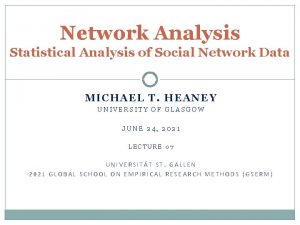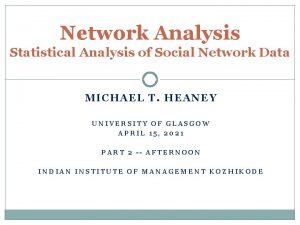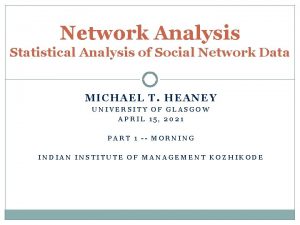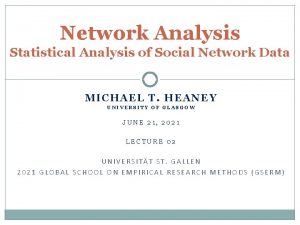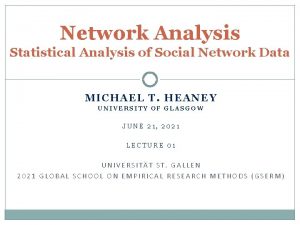CS 498 KA Social Network Analysis Refs D

![Introduction: Social Network Analysis ● “ [SNA is the] systematic study of collections of Introduction: Social Network Analysis ● “ [SNA is the] systematic study of collections of](https://slidetodoc.com/presentation_image_h/26b219a40729642afe357932506b026c/image-2.jpg)


















- Slides: 20

CS 498 KA Social Network Analysis Refs: D Hansen, M Smith (content), M Bays, H Cui (slide design)
![Introduction Social Network Analysis SNA is the systematic study of collections of Introduction: Social Network Analysis ● “ [SNA is the] systematic study of collections of](https://slidetodoc.com/presentation_image_h/26b219a40729642afe357932506b026c/image-2.jpg)
Introduction: Social Network Analysis ● “ [SNA is the] systematic study of collections of social relationships” ● social actors implicitly or explicitly connected to one another ○ ○ entities (e. g. , people, organizations, nodes) joined together by relationships (e. g. , ties, associations, links, edges) more about “who you know” than “what you know” or “who you are. ”

Introduction ● HCI context ○ ○ ○ Provide theory and methods for better understanding/evaluating systems Distinguishes between simple population growth and the development of social structures within that population ■ Success may depend on small population with a dense connections web as opposed to large population with sparser connections ■ Capture the social structure of a user population before, during, and after new technologies Help identify potential influencers who can recruit new users

History ● Social networks have formed for as long as people have interacted, traded, and engaged with one another ● Prior to the widespread use of digital information systems, generating records of social interactions was challenging ● Evolution of the methodology of social network analysis can be split into three phases: ○ ○ ○ Foundational Phase Computational Phase Network Data Deluge Phase

History ● The Foundational Phase (Eighteenth century to the 1970’s) ○ Defining and establishing the necessary mathematical graph theory foundation ■ Euler demonstrated value of using graph theory representation to solve mathematical puzzles ■ Erdős and Rényi provided formal mechanisms for generating random graphs that made statistical tests of network properties viable ○ Sociologists focused on patterns of social ties (as opposed to the study of individuals) ■ applied formal mathematical methods to describe, analyze, and visualize networks in what was then described using terms such as “sociometrics” and “sociograms” ■ Milgram’s famous “six degrees of separation” study involving chain letters

History ● The Computational Phase (1970’s - mid 1990’s) ○ ○ ○ Creation and systematic use of computational tools and methods Leveraged the new capabilities of computers to analyze and visualize networks Homans developed new techniques for identifying subgroups (i. e. , clusters) in networks, while White developed techniques for finding people that occupy similar network positions (via “structural equivalence”) Founding SNA Sociologist Barry Wellman argued “SNA is not simply a method but is the core paradigm for explaining social action”

History ● Network Data Deluge Phase (Mid 1990’s to Present) ○ wealth of real-time social network data is captured by our everyday use ○ SNA no longer purely academic ■ corporations, governments, and NPOs utilize SNA techniques to find criminals, rank Web sites, recommend books, identify influencers, restructure organizations. ■ analysis of social networks at a scale never before possible

Human. Computer Interaction: SNA Goals 1. Inform the design and implementation of new Computer-Supported Cooperative Work (CSCW) systems. ● Characterize the social structure of a population of intended users ○ clarify requirements and challenges, better initial designs ○ Identify individuals with unique/important network positions 2. Understand improve current CSCW systems. ● ● Data from existing systems shows how current features are utilized by users ○ For example, “unfollowing” someone on Twitter partly explained by social network structures Help community managers understand what is happening in large scale communities ○ Allow designers to develop tools that meet the particular needs of subpopulations

Human. Computer Interaction: SNAGoals 3. Evaluate the impact of CSCW system on social relationships. ● Many systems are designed to influence the social relationships of users ○ ● online exchange markets match buyers and sellers, corporate intranets help employees find internal experts Evaluation can be performed to assess the impact of a specific feature or social intervention. ○ online “icebreaker” activity assessed by looking at changes in the network 4. Design novel CSCW systems and features using SNA methods. ● Allows input to new systems and features ○ Tool that recommends potential friends on a social networking site uses SNA properties ○ Tools leverage network analysis and visualization to help gain insights into large datasets

Human. Computer Interaction: SNAGoals 5. Answer fundamental social science questions. ● Growing field of “computational social science” ○ Test hypotheses and theories at a much larger scale ■ Study of Facebook helped support and extend Granovetter’s original work that showed the importance of “weak ties” ■ Reducing the need for raw or self-reported data collection

Social Network Analysis Questions ● Questions About Individual Social Actors ○ ● Questions About Overall Network Structure ○ ● Identifying individuals who play an important or unique role within a particular social network ■ Who is most popular? ■ Who has the most influence? ■ Who is a bridge spanner? Focus on overall distribution instead of focusing on the position of individuals ■ How interconnected are a group? ■ What is the distribution of individual network properties or social roles? ■ Are there subgroups of highly connected users ? Questions About Network Dynamics and Flows ○ How ■ ■ ■ networks change over time How do the structures of social relationship change? How does the importance of specific individuals, social roles, or clusters change? How does information spread?

Performing Social Network Analysis ● Identify Goals and Research Questions It is essential that analysts hone in on a few critical goals and turn them into specific research questions, lest they spend unreasonable amounts of time aimlessly meandering around the data.

Performing Social Network Analysis ● Collect Data ○ Sources of Network Data Source Effort level Raw data from system usage Medium - High Network survey High Application programming interfaces Medium - High Screen scraping Medium - High Network analysis importer tools Easy Existing datasets Easy

Performing Social Network Analysis ● Collect Data ○ ○ ○ Sources of Network Data Types of Social Networks Representing Network Data

What Constitutes Good Work ● ● ● Use appropriate network metrics Do not claim more than what your data can support Use network virtualization that illustrates the core points Use appropriate statistical techniques to compare to baseline model Look at exemplary work for appropriate methods and techniques

Example Research Application Inferring friendship network structure by using mobile phone data ● Goal ○ demonstrate the power of collecting not only communication information but also location and proximity data from mobile phones over an extended period, and compare the resulting behavioral social network to self-reported relationships from the same group. ● Method ○ ○ ○ Observed 94 subjects using phones with software recording data over the period of nine months Collected self-reported proximity data from participants about their relationships Constructed social network graphs from observed data and self reported data

Example. Research. Applications The graphed networks overlap significantly, but are distinct in that long term relationships may not require constant proximity to exist, and self-reported data suffers from salience bias(how vivid an event was) and recency bias (how recent an event was)

Example. Research Applications - Twitter Goals ● How are people connected? ● What are the most influential people and topics ● How does information diffuse via retweet Data Collection ● Twitter API ○ ○ ○ User Profile Trending topics Tweets

Example. Research Applications - Twitter Analysis and Visualization

Looking Towards the Future ● With rise of Big Data as a field , SNA will draw from unprecedented amounts of information ○ ○ Allows for more evidence for past SNA studies Brings up new questions for SNA to explore, across research fields and disciplines ● SNA will continue to flourish as our social lives become increasingly mediated by technology
 Cs 498 vr
Cs 498 vr Eecs 498
Eecs 498 Cs 498 vr
Cs 498 vr Eecs 498
Eecs 498 Quem pode o mais pode o menos
Quem pode o mais pode o menos Cs 498 vr
Cs 498 vr Ece 498
Ece 498 +1 (432) 498-0251
+1 (432) 498-0251 498
498 498
498 Umich eecs 498
Umich eecs 498 Cs 498 cloud computing applications
Cs 498 cloud computing applications Upute za izradu plakata
Upute za izradu plakata Cs 498 vr
Cs 498 vr Eecs 498
Eecs 498 Ece 498
Ece 498 Social network analysis tutorial
Social network analysis tutorial Network analysis for dummies
Network analysis for dummies Stata network analysis
Stata network analysis Mitchell centre for social network analysis
Mitchell centre for social network analysis Machine learning social network analysis
Machine learning social network analysis
